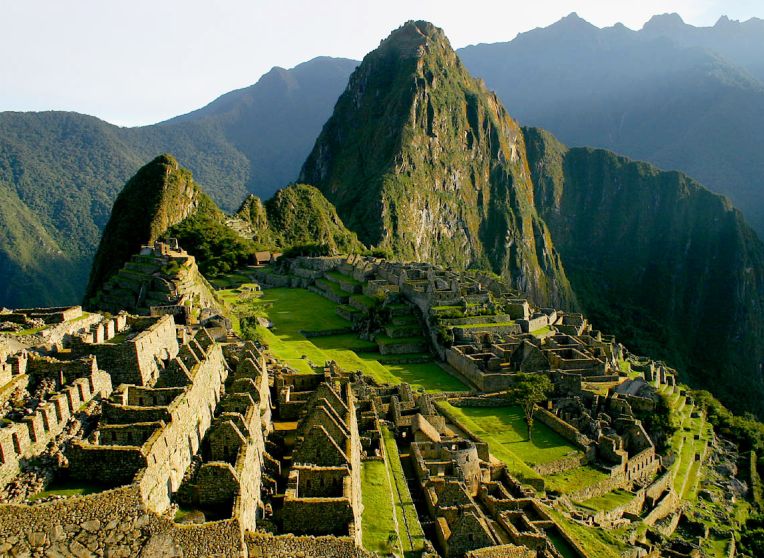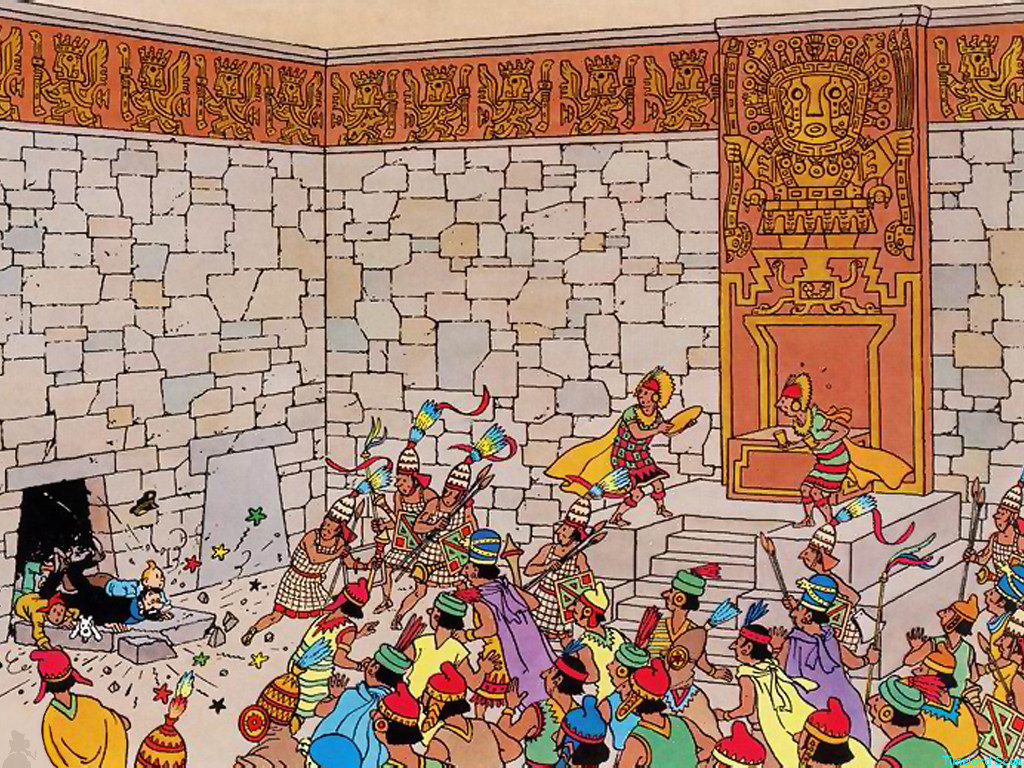This Christmas I received the most remarkable as well as the most unexpected gift of my life. Ever since I was a boy, I have longed to see the Incan city of Machu Picchu. My wife and my son Darien and his wife are sending me there this coming summer.
We haven’t settled yet on the particular tour so I’m doing research into different possibilities. I know that I will want the trip to be as information-rich as possible.
Whence my fascination? I know that I read a book when I was in middle school called Lost Cities and Vanished Civilizations by Robert Silverberg. It was available through the Junior Scholastic Book Club and I couldn’t get enough of it. Although I was drawn also to the Mayans, I think the Incans were my favorite vanished civilization because I too grew up on top of a mountain.
Not longer after reading Silverberg’s book, I discovered Hergé’s Tintin adventure Prisoners of the Sun. I’ve since realized how Eurocentric and even racist the book is, but at the time it enthralled me.
There is something about lost cities and vanished civilizations in general, not just the Incas, that sets the imagination ablaze. They have immense potential because reality no longer circumscribes their limits. The lost city of Atlantis in particular has fired people’s fantasies because it’s a city that has altogether disappeared—they’re aren’t even ruins that we know of unless (as some believe) Atlantis was actually the island of Crete, destroyed by a volcano-caused tidal wave. Italo Calvino’s novel Invisible Cities takes advantage of how all things become possible in an imagined city.
I remember a Swedish children’s book that helped me understand how this imagination process works. In Selma Lagerlof’s The Adventures of Nils, read to me by my father, Nils has been shrunk in size and is flying all over Sweden on the backs of a flock of Canadian geese. At one point a stork acquaintance, Herr Ermenrich, awakens him in the middle of the night and takes him to the shore. I include the detail of his finding a worn coin because it will prove important:
To start with, the boy intended to climb a sand-hill and see how the land behind it looked. But when he had walked a couple of paces, he stubbed the toe of his wooden shoe against something hard. He stooped down, and saw that a small copper coin lay on the sand, and was so worn with verdigris that it was almost transparent. It was so poor that he didn’t even bother to pick it up, but only kicked it out of the way.
But when he straightened himself up once more he was perfectly astounded, for two paces away from him stood a high, dark wall with a big, turreted gate.
The moment before, when the boy bent down, the sea lay there—shimmering and smooth, while now it was hidden by a long wall with towers and battlements. Directly in front of him, where before there had been only a few sea-weed banks, the big gate of the wall opened.
Nils wanders through the city, which proves to be opulent and beautiful:
In the deep archway there were guards, dressed in brocaded and purred suits, with long-handled spears beside them, who sat and threw dice. They thought only of the game, and took no notice of the boy who hurried past them quickly.
Just within the gate he found an open space, paved with large, even stone blocks. All around this were high and magnificent buildings; and between these opened long, narrow streets. On the square—facing the gate—it fairly swarmed with human beings. The men wore long, fur-trimmed capes over satin suits; plume-bedecked hats sat obliquely on their heads; on their chests hung superb chains. They were all so regally gotten up that the whole lot of them might have been kings.
At first Nils passes unseen through the city but, when a merchant sees him, he is led to understand that the city will be restored if he buys anything. He rushes out to retrieve the coin but, by the time he gets back, the city has disappeared. The stork explains what has happened:
“But I will not conceal from you that Bataki, the raven, who is the most learned of all birds, once told me that in former times there was a city on this shore, called Vineta. It was so rich and so fortunate, that no city has ever been more glorious; but its inhabitants, unluckily, gave themselves up to arrogance and love of display. As a punishment for this, says Bataki, the city of Vineta was overtaken by a flood, and sank into the sea. But its inhabitants cannot die, neither is their city destroyed. And one night in every hundred years, it rises in all its splendour up from the sea, and remains on the surface just one hour.”
“Yes, it must be so,” said Thumbietot [Nils], “for this I have seen.”
“But when the hour is up, it sinks again into the sea, if, during that time, no merchant in Vineta has sold anything to a single living creature. If you, Thumbietot, only had had an ever so tiny coin, to pay the merchants, Vineta might have remained up here on the shore; and its people could have lived and died like other human beings.”
“Herr Ermenrich,” said the boy, “now I understand why you came and fetched me in the middle of the night. It was because you believed that I should be able to save the old city. I am so sorry it didn’t turn out as you wished, Herr Ermenrich.”
He covered his face with his hands and wept. It wasn’t easy to say which one looked the more disconsolate—the boy, or Herr Ermenrich.
This is not the end of the matter, however. Seeing how disconsolate Nils is, the geese take him to another city to teach him a lesson:
The boy came from the east, and the sun had just begun to go down in the west. When he came nearer the city, its walls and towers and high, gabled houses and churches stood there, perfectly black, against the light evening sky. He couldn’t see therefore what it really looked like, and for a couple of moments he believed that this city was just as beautiful as the one he had seen on Easter night.
When he got right up to it, he saw that it was both like and unlike that city from the bottom of the sea. There was the same contrast between them, as there is between a man whom one sees arrayed in purple and jewels one day, and on another day one sees him dressed in rags.
Yes, this city had probably, once upon a time, been like the one which he sat and thought about. This one, also, was enclosed by a wall with towers and gates. But the towers in this city, which had been allowed to remain on land, were roofless, hollow and empty. The gates were without doors; sentinels and warriors had disappeared. All the glittering splendour was gone. There was nothing left but the naked, gray stone skeleton.
The same contrast is also that between an imagined city and an actual one. Nils feels better for not having saved Vineta:
When they had arranged themselves for sleep, Thumbietot was still awake and looked up through the open arches, to the pale pink evening sky. When he had been sitting there a while, he thought he didn’t want to grieve any more because he couldn’t save the buried city.
No, that he didn’t want to do, now that he had seen this one. If that city, which he had seen, had not sunk into the sea again, then it would perhaps become as dilapidated as this one in a little while. Perhaps it could not have withstood time and decay, but would have stood there with roofless churches and bare houses and desolate, empty streets—just like this one. Then it was better that it should remain in all its glory down in the deep.
“It was best that it happened as it happened,” thought he. “If I had the power to save the city, I don’t believe that I should care to do it.” Then he no longer grieved over that matter.
The author, however, disagrees in a way that I think I will disagree with Nils once I see Macchu Piccu:
And there are probably many among the young who think in the same way. But when people are old, and have become accustomed to being satisfied with little, then they are more happy over the Visby that exists, than over a magnificent Vineta at the bottom of the sea.
When I make my journey, I think I will be just as interested in how the civilization has evolved to present-day Peru—in how the Incas are still alive, even if no longer so magnificent—as I will be in its past history. The living fascinate me even more than the dead.
But that being acknowledged, I suspect there will also be moments where my imagination will soar without restraint. I’ll let you know.




One Trackback
[…] Friday I leave for Cusco and Machu Picchu to fulfill a life-long dream. Ever since I read Lost Cities and Vanished Civilizations by Robert Silverberg. in seventh grade (I ordered it through Junior Scholastic Book Club), I have dreamed of visiting the legendary Incan sites. I’ll report on the trip when I get back. (I have posted in advance a series of essays for this blog so there won’t be any gaps.) […]